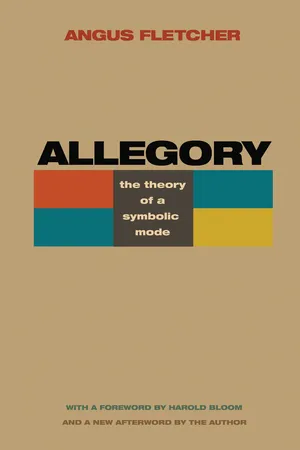
- 472 pages
- English
- PDF
- Available on iOS & Android
About this book
Anyone who has ever said one thing and meant another has spoken in the mode of allegory. The allegorical expression of ideas pervades literature, art, music, religion, politics, business, and advertising. But how does allegory really work and how should we understand it? For more than forty years, Angus Fletcher's classic book has provided an answer that is still unsurpassed for its comprehensiveness, brilliance, and eloquence. With a preface by Harold Bloom and a substantial new afterword by the author, this edition reintroduces this essential text to a new generation of students and scholars of literature and art.
Allegory puts forward a basic theory of allegory as a symbolic mode, shows how it expresses fundamental emotional and cognitive drives, and relates it to a wide variety of aesthetic devices. Revealing the immense richness of the allegorical tradition, the book demonstrates how allegory works in literature and art, as well as everyday speech, sales pitches, and religious and political appeals.
In his new afterword, Fletcher documents the rise of a disturbing new type of allegory--allegory without ideas.
Frequently asked questions
- Essential is ideal for learners and professionals who enjoy exploring a wide range of subjects. Access the Essential Library with 800,000+ trusted titles and best-sellers across business, personal growth, and the humanities. Includes unlimited reading time and Standard Read Aloud voice.
- Complete: Perfect for advanced learners and researchers needing full, unrestricted access. Unlock 1.4M+ books across hundreds of subjects, including academic and specialized titles. The Complete Plan also includes advanced features like Premium Read Aloud and Research Assistant.
Please note we cannot support devices running on iOS 13 and Android 7 or earlier. Learn more about using the app.
Information
Table of contents
- Cover Page
- Title Page
- Copyright Page
- Dedication
- Contents
- List of Illustrations
- A Personal Foreword, Harold Bloom
- Acknowledgments
- Introduction
- 1. The Daemonic Agent
- 2. The Cosmic Image
- 3. Symbolic Action: Progress and Battle
- 4. Allegorical Causation: Magic and Ritual Forms
- 5. Thematic Effects: Ambivalence, the Sublime, and the Picturesque
- 6. Psychoanalytic Analogues: Obsession and Compulsion
- 7. Value and Intention: The Limits of Allegory
- Afterword
- Afterword to the 2012 Edition
- Illustrations
- Bibliography
- Index